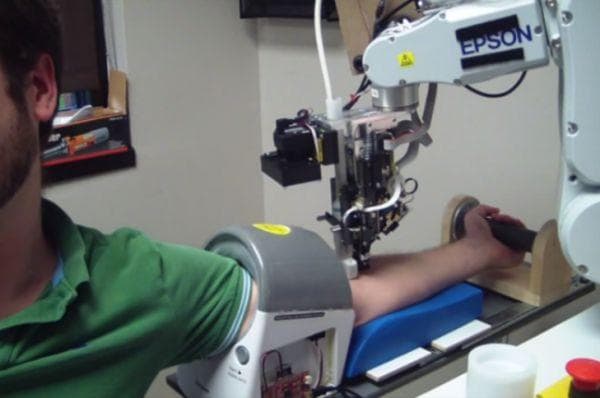Veebot Draws Your Blood More Accurately Than Your Doctor
Almost all of you might have gone through the painful procedure of getting your blood drawn for diagnostic tests. While in some tests a drop of blood is enough for a sample others require almost a vial of your blood and in these situations the medical professional has to find your vein and this is where the problem lies - He/she might not get the vein in the first try and has to give it another go. So to make this process an accurate one, a California based startup has come up with Veebot. The medical technician robot uses infrared light and ultrasound to get the best vein for extracting the blood and in its prototype stage has an accuracy of 83%. Let us now see how this robot works.

The patient first has to insert his/her arm into the robot through its padded archway that has inflatable cuff which used to restrict the blood flow making the veins more prominent. Then a infrared light is used to illuminate the arm. The software then tries to match this view of the arm with the one that has been stored in its memory to locate the vein. Once the vein is located it is then examined with the help of ultrasound to make sure that enough blood is flowing through it before sticking in the needle. While the entire process is automatic, the machine still needs a human who has to attach vials to it.
Before proceeding for a clinical trial, the makers of Veebot want its accuracy rate to be increased to 90%. This technology immense potential in the medical industry and its inventor Richard Harris, a third-year undergraduate in Princeton’s mechanical engineering department estimates that his product has an estimated market of nine million dollars in the US alone.
To know more about the Veebot check out the <a href="https://www.veebot.com/" target="_blank" rel="nofollow noopener noreferrer">VEEBOT SYSTEMS INC - Home</a> and its coverage on #-Link-Snipped-# and <a href="https://www.digitaltrends.com/cool-tech/sit-still-veebot-is-trying-to-draw-your-blood/" target="_blank" rel="nofollow noopener noreferrer">Sit still, Veebot is trying to draw your blood | Digital Trends</a>. Also do not forget to check out this video below.

The patient first has to insert his/her arm into the robot through its padded archway that has inflatable cuff which used to restrict the blood flow making the veins more prominent. Then a infrared light is used to illuminate the arm. The software then tries to match this view of the arm with the one that has been stored in its memory to locate the vein. Once the vein is located it is then examined with the help of ultrasound to make sure that enough blood is flowing through it before sticking in the needle. While the entire process is automatic, the machine still needs a human who has to attach vials to it.
Before proceeding for a clinical trial, the makers of Veebot want its accuracy rate to be increased to 90%. This technology immense potential in the medical industry and its inventor Richard Harris, a third-year undergraduate in Princeton’s mechanical engineering department estimates that his product has an estimated market of nine million dollars in the US alone.
To know more about the Veebot check out the <a href="https://www.veebot.com/" target="_blank" rel="nofollow noopener noreferrer">VEEBOT SYSTEMS INC - Home</a> and its coverage on #-Link-Snipped-# and <a href="https://www.digitaltrends.com/cool-tech/sit-still-veebot-is-trying-to-draw-your-blood/" target="_blank" rel="nofollow noopener noreferrer">Sit still, Veebot is trying to draw your blood | Digital Trends</a>. Also do not forget to check out this video below.
0
